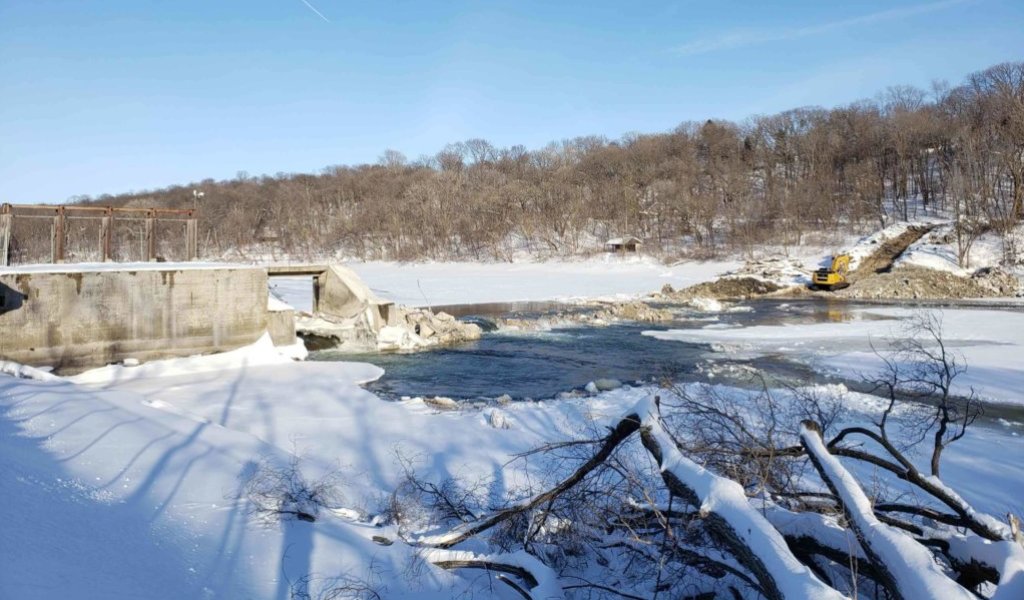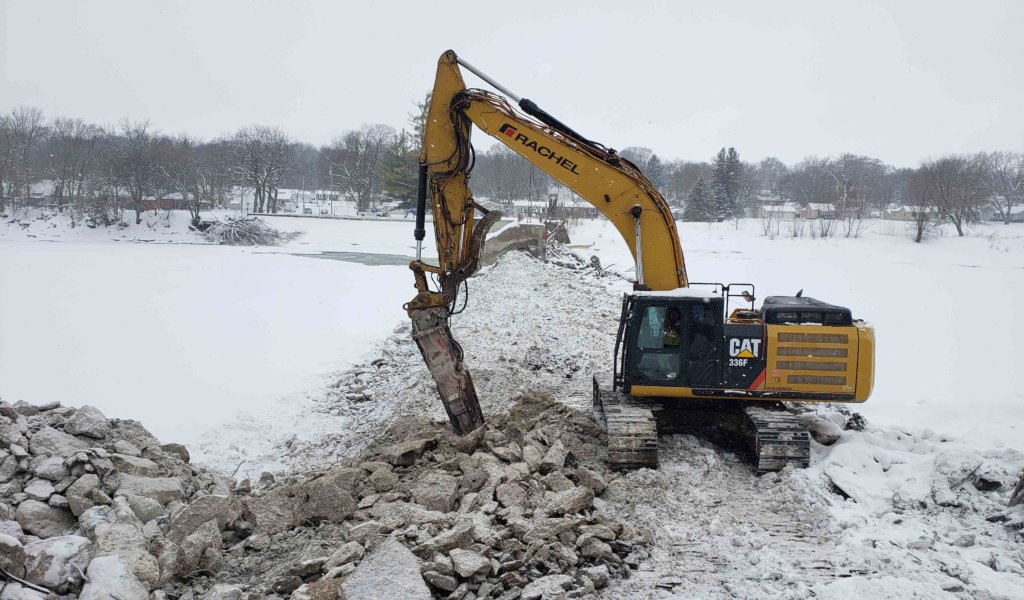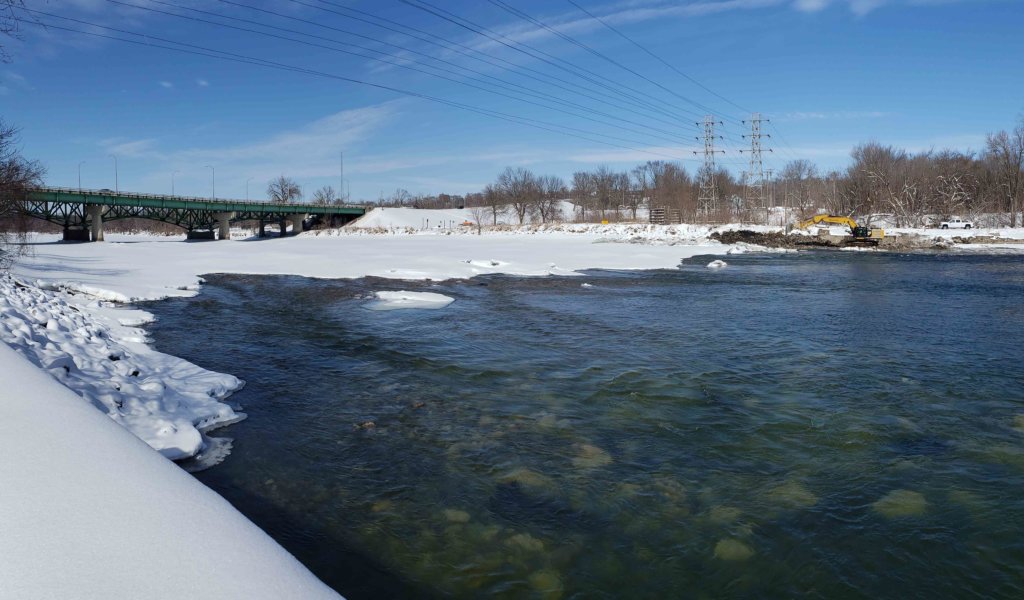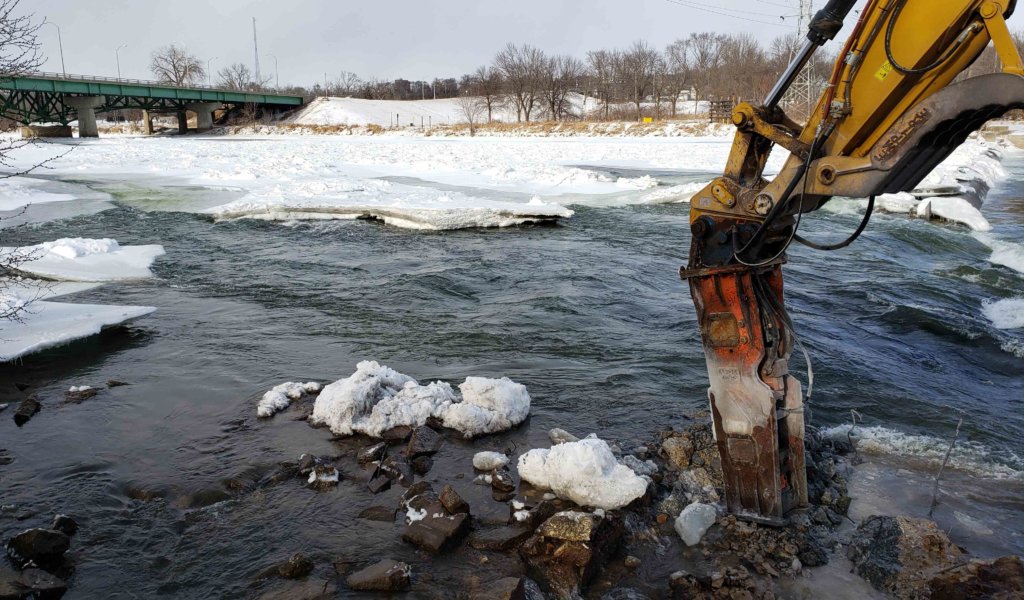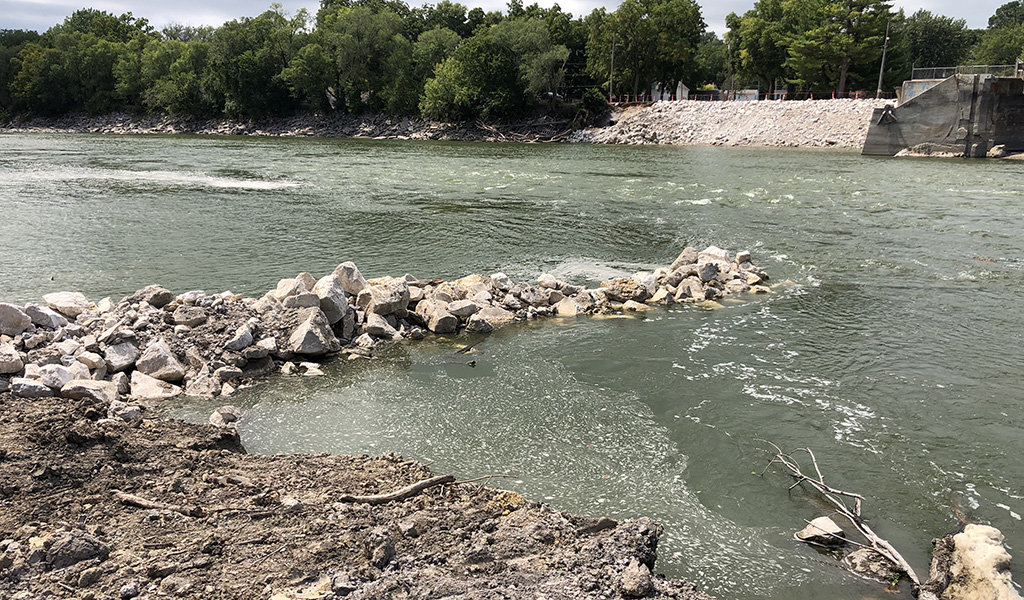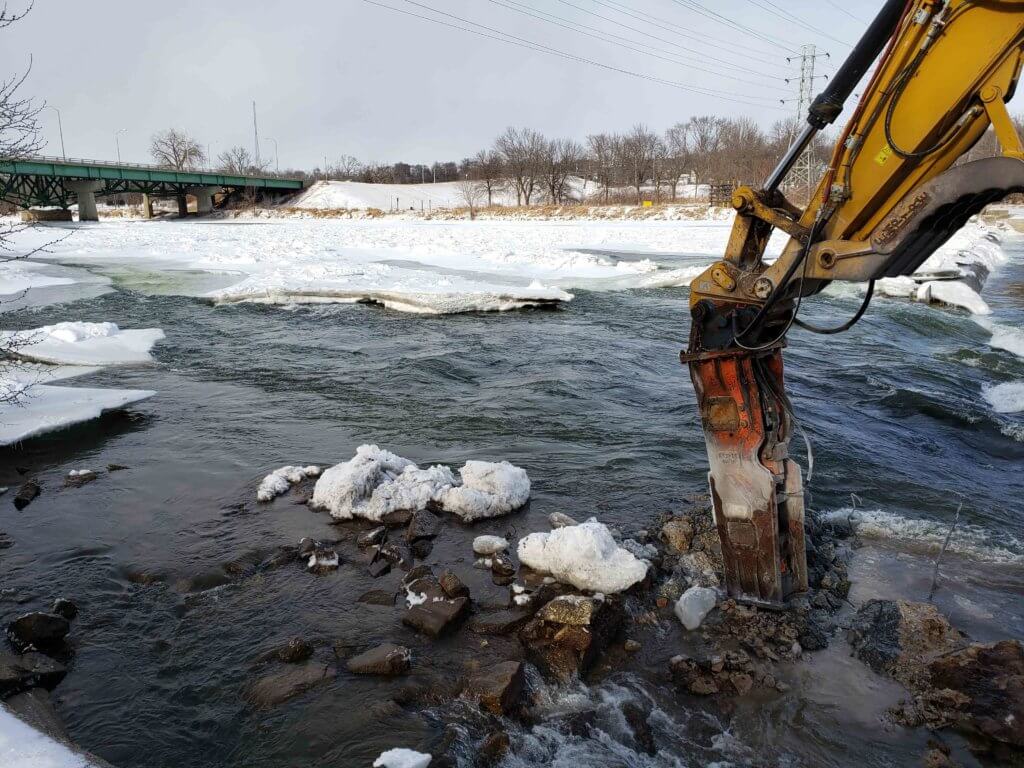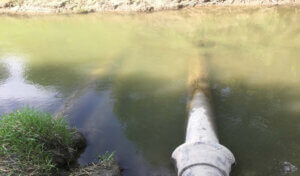
Improving River Safety, Water Quality & Recreation Through Dam Removal
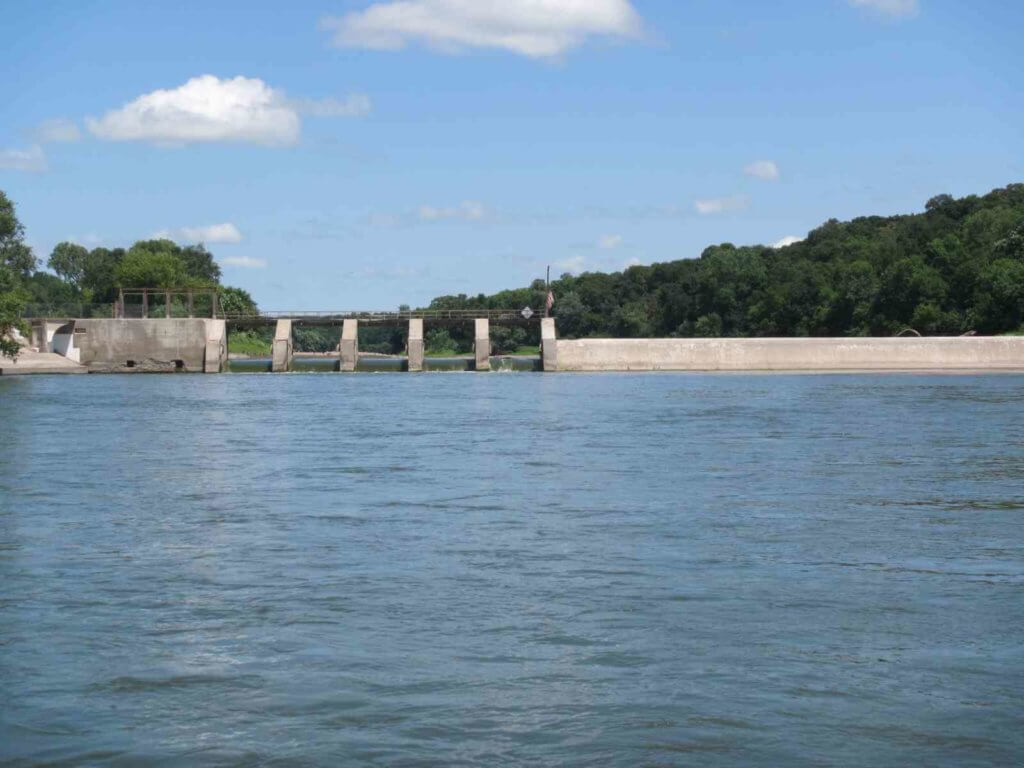
Hydroelectric Dam
The Des Moines River serves as a primary water source for numerous communities within the Des Moines River watershed. It’s also a popular recreation destination for anglers, water sports enthusiasts, and people who enjoy the beauty of rivers. At approximately 525 miles long, it’s also the largest river in Iowa and a tributary of the Mississippi River.
Central to the project is the removal of the Fort Dodge Hydroelectric Dam and a smaller dam, known as Little Dam, which lies two miles south. Constructed in 1916, the Fort Dodge Hydroelectric Dam generated electricity for the downtown street lights until 1971 when it was decommissioned. It has since been abandoned, with subsequent gate failures contributing significantly to a decline in water quality of the river.
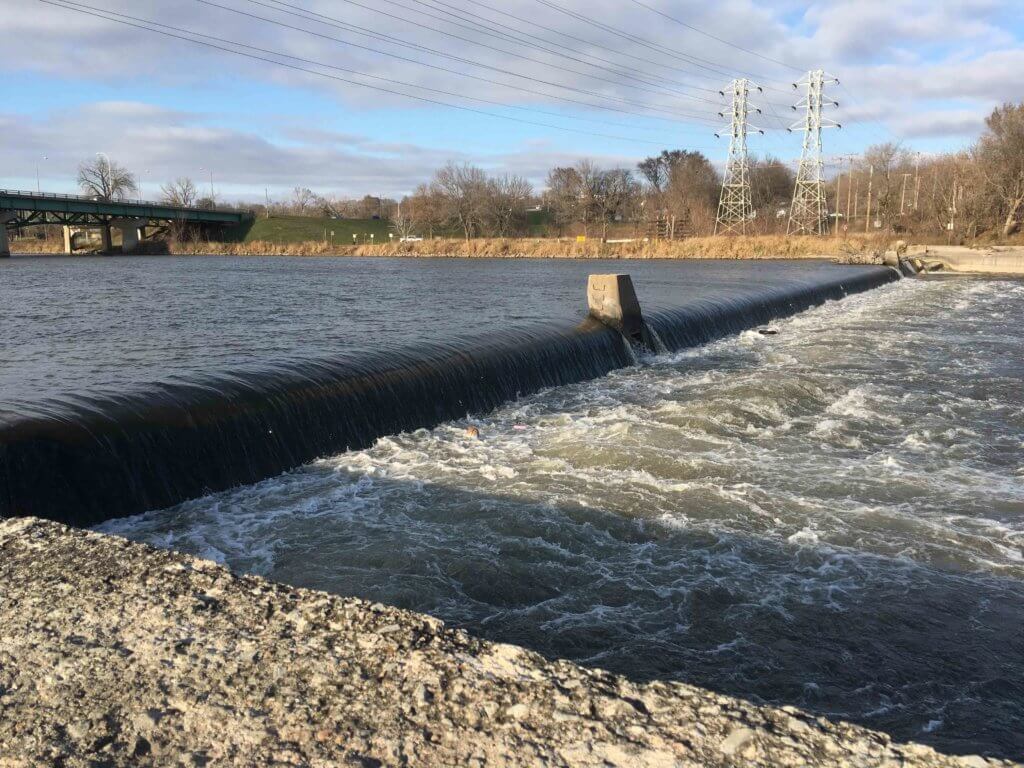
Little Dam
Both the Hydroelectric Dam and Little Dam were recommended for removal as part of the Des Moines River and Lizard Creek Water Trails and Corridor Plan. By demolishing the dams, the natural flow of the river can be restored, while providing positive impacts to the aquatic environment and safety for recreational users. In this instance, the environmental benefits of dam removal outweigh the benefits of maintaining the dam.
The primary goals for this dam removal project include:
- Improving the integrity of the river by preventing future degradation
- Restoring natural in-stream habitat conditions
- Meeting the designated uses for the river
Stream Mitigation Banking
Snyder & Associates initially secured funding from the Clean Water State Revolving Fund (CWSRF) program to pay for the dam removal. The program provides communities with a low-cost financing source for a wide range of water quality infrastructure projects through a federal-state partnership. After further review of additional project funding streams, the Snyder environmental team recommended the creation of a stream mitigation bank in lieu of using CWSRF funds. This recommendation adds significant value to the dam removal project for the City of Fort Dodge.
Wetland and stream mitigation banks provide the opportunity to purchase credits for unavoidable impacts to aquatic resources. Section 404 of the Clean Water Act requires a no net loss of waters of the United States (WOTUS). Any loss of stream requires mitigation, which can be in the form of purchasing credits from a mitigation bank. The City of Fort Dodge and their stream mitigation bank can sell credits to entities that need mitigation for projects.
Development of the stream mitigation bank included drafting a prospectus document and Mitigation Bank Instrument with review from the U.S. Army Corps of Engineers (USACE), Iowa Department of Natural Resources (DNR), U.S. Environmental Protection Agency (EPA), United States Fish and Wildlife Service (USFWS), and Natural Resources Conservation Service (NRCS).
The mitigation banking instrument was developed to outline the dam removal process, identify enhancement and restoration efforts in the river, and calculate the number of credits generated by the removals and enhancements. The bank approval process took approximately two years and was completed concurrently with deconstruction planning, agency coordination, and obtaining permits for the dam removal. Our team created a stream mitigation banking system for the region that is currently being monitored annually.
Environmental Studies Required for Dam Removal
Dam removal decisions can be complex. The demolition work resolved decades of debate over the future of the Des Moines River dams. It required regulators and owners to evaluate long-term maintenance costs against the costs of removal. Scientific research has improved our knowledge of river systems and the effects dams can have on a region’s environmental health.
Since the project began, we’ve completed several tasks as part of a fluvial geomorphological assessment preparing the site for dam removal. As we navigated the environmental compliance process, we worked with several regulatory agencies including the USACE, EPA, USFWS, and Iowa DNR to efficiently manage the restoration of the river.
- Bathymetric survey – determines the river’s geometry and provides insight into the depth and shape of the river
- Depth of refusal probing – quantifies the volume of silty material located upstream of each dam
- Cross-sectional survey – creates a complete profile of the river
- Wetland and stream delineation – investigates the potential impact of the project on the surrounding area
- River condition assessment – evaluates how the river is functioning and the health of dependent populations of aquatic and terrestrial species
- Threatened and endangered species study – identifies the presence of listed species and habitats that require protection
- Hydraulic modeling – detailed one-dimensional and two- dimensional models of the existing conditions and proposed improvements
- Preliminary deconstruction plans and cost estimates
Dam Removal Permitting Requires Critical Agency Coordination
Removing a dam from a river requires permits from state, federal, and local authorities. Snyder & Associates has successfully navigated the permitting process numerous times, establishing valuable agency relationships. As a result, agency review time is reduced, which allows our clients to expedite their projects. These strategies were applied directly to the permitting required for Fort Dodge from the Iowa DNR with a review from local DNR fisheries. The permits included Sovereign Land, Dam Safety, and Floodplain, along with a Section 404 permit from the USACE.
A roundtable meeting was held with the State Historic Preservation Office (SHPO), USACE, City of Fort Dodge, and Snyder & Associates in order to obtain concurrence between SHPO and USACE for the dam removal. The Hydroelectric Dam is a register-eligible structure under Section 106 of the National Historic Preservation Act. SHPO required additional alternatives from the USACE to avoid or minimize impacts to the Hydroelectric Dam. On behalf of the USACE and Fort Dodge, Snyder developed mitigation alternatives and restoration measures, enabling SHPO to issue a No Adverse Effect determination. These measures include:
- Retain the powerhouse foundation and westernmost tainter gate frame, which is attached to the pump house foundation
- Make repairs as needed to the stone steps at Loomis Park
- Make repairs as needed to the exterior of the picnic shelter and picnic cabin at Hydroelectric Park
Enhancements to the Des Moines River Encourage Water-Oriented Activities
Both the Hydroelectric and Little Dam have been successfully removed allowing the Des Moines River to once again flow naturally. River length increases through dam removal, allowing boaters and kayakers to explore areas that were once dangerous to navigate. Anglers also benefit due to an increase in fish species diversity and longer migration lengths following dam removal.
Moving into the next phase of the project, the Snyder & Associates design team is preparing plans for in-stream features at Hydroelectric Park, Little Dam, and the Central River District. The design strategy preserves the river’s natural aesthetic qualities. Improving its natural function, minimizes recreational conflicts with users, such as anglers. Kayakers and water enthusiasts will be able to traverse rapids. The addition of whitewater structures will likely drive recreation, stewardship, and community connections.
Numerous Snyder Services Streamline the Multi-Phased Project
Snyder & Associate’s staff is provided a variety of civil engineering services for this project including permitting, GIS mapping and analysis, hydrologic modeling, survey, and wetland mitigation banking. Current work includes:
- Construction of in-stream features and bank stabilization near Hydroelectric Park
- Monitoring stream mitigation bank
- Land planning and conceptual development of additional in-stream features for recreational uses including kayaking and angling
The Iowa Chapter of the American Planning Association presented the Implementation Award to Snyder & Associates to recognize their work on the removal of the two Des Moines River dams. The Implementation Award recognizes a project that demonstrates a significant achievement resulting in positive change for an area due to planning. This award emphasizes long-term, measurable results.
Check out our newest video to learn more about the APA Award-winning project.
